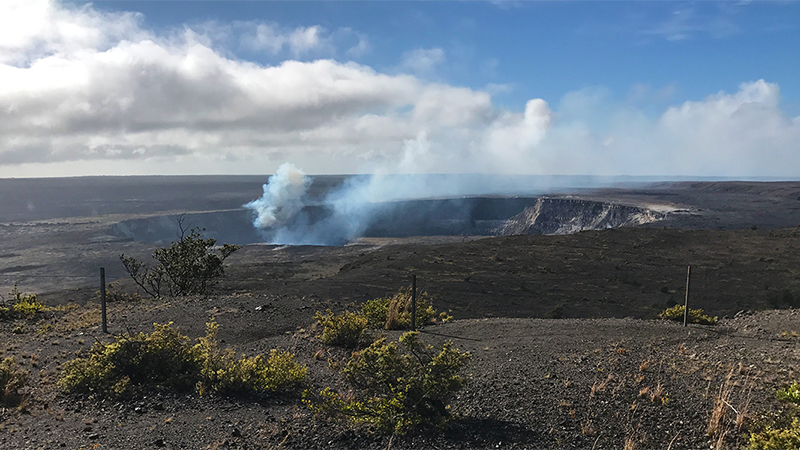
After dinner on our first night in the park, we hopped in the car and drove over to the Jaggar Museum to see bubbling lava in the Halema`uma`u Crater of the Kīlauea Caldera. But when we got out of the car, it was freezing! We hustled to the overlook as fast as we could and got to see the red glow of lava, but it was so cold, our fingers, toes, and ears were burning, so we hightailed it back to the car and planned to visit again the next day in warmer clothes!
On our second day in the park, we actually visited the Jaggar Museum twice.
- We went in the morning so we could actually go inside the museum, check out the exhibits and gift shop, and see the caldera and crater in the sunlight. We were lucky enough to also see an incredible rainbow stretch over the parking lot.
- We visited again after dinner at night to get a better look at the amazing, glowing molten lava in the dark. It was so could our faces felt like they were freezing, but this time we worse lots of layers and our bodies stayed much warmer.
Jaggar Museum
The Thomas A. Jaggar Museum is a museum on volcanology with displays of equipment used by scientists to study the volcano, state-of-the-art seismographs, an exhibit of clothing and gear from scientists who got too close to lava, and video screens showing footage of lava flows. There are also several Hawaiian cultural exhibits and a gift shop with books, videos, maps, shirts, souvenirs, and other items for sale.
The Museum has large windows with a view of the Kīlauea Caldera and the fuming vent in Halema’uma’u Crater, which is awesome for rainy days!
The Jaggar Museum Overlook provides panoramic views of Kīlauea Caldera, interpretive displays about one of the world’s most active volcanoes, and breathtaking views of Halema’uma’u Crater.
Halema’uma’u is an ongoing eruption that began on March 19, 2008. Prior to the 2008 eruption, the diameter of the vent was around 125 feet. Over the years it has continued to expand, and today it measures 525 feet.
Hawai’i Volcano Observatory
In 1908, an earthquake killed 125,000 people near Mount Etna in Italy. This disaster inspired Dr. Thomas A. Jaggar of the Massachusetts Institute of Technology (MIT) to pursue systematic, ongoing studies of volcanic and seismic activity.
In 1909, Jaggar traveled to Honolulu, Hawai’i to give a lecture and afterward, he was approached by Lorrin A. Thurston, a prominent Honolulu attorney and businessman who believed that Kīlauea was a prime site for a permanent volcano observatory. Within a year, Thurston and other businessmen raised the funds to create the Hawai’i Volcano Research Association and a small observation station was set up on the rim of Halema’uma’u Crater.
In 1912, Dr. Thomas Jaggar spearheaded the construction of the new Hawai’i Volcano Observatory (HVO) began near the Volcano House. Jaggar remained Director of HVO until 1940.
In 1985, the current Hawai’i Volcano Observatory and Jaggar Museum were built on the highest point of the crater rim. Here scientists use the latest technology to monitor the volcano and it is off limits to the public.
Know Before You Go
- The Jaggar Museum overlooking the Kīlauea Caldera and Halema’uma’u Crater is located 0.6 miles from the Kīlauea Overlook and 2.5 miles from the Kīlauea Visitor Center on Crater Rim Drive in Hawai’i Volcanoes National Park.
- This is one of only a few locations in the national park where you can see hot lava!
- Open daily from 10:00 am to 8:00 pm but hours are subject to change due to volcanic activity.
- Admission is free.
- This is one of the busiest locations in Hawai’i Volcanoes National Park and the parking lot can fill up, so try to visit early in the day or arrive about 30 minutes before sunset.
- Accessible flush restrooms, water, and phones are available. As well as a gift shop and bookstore.









